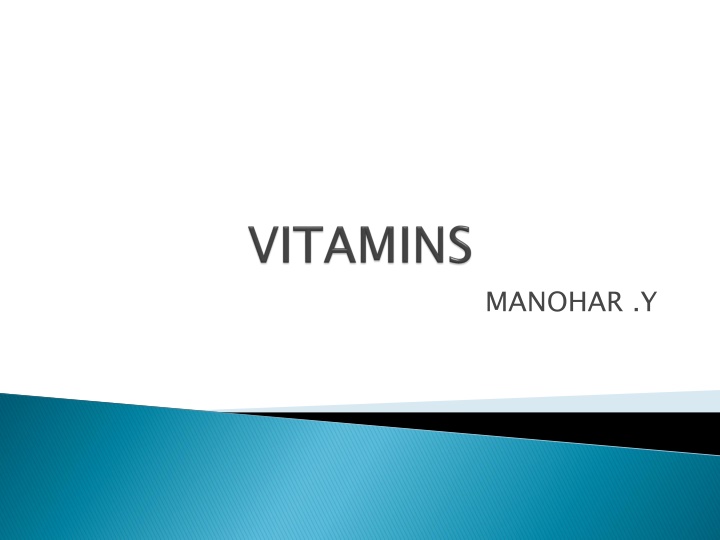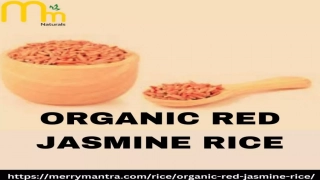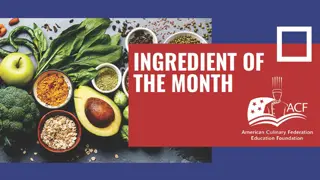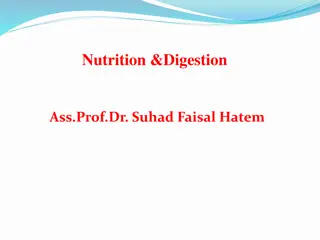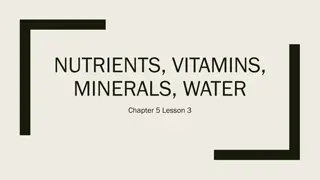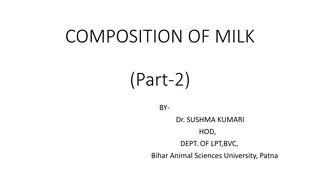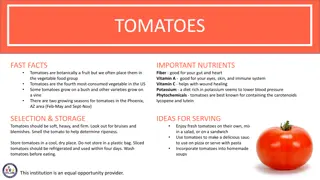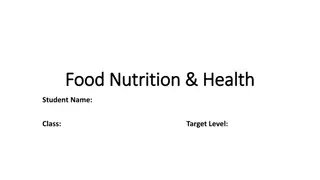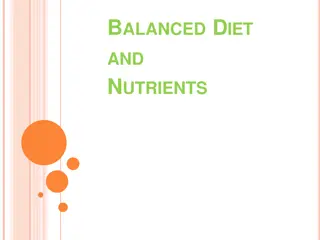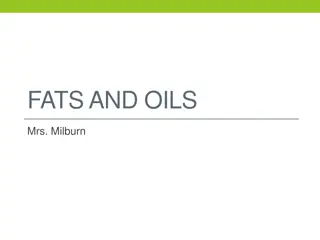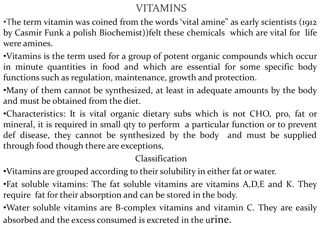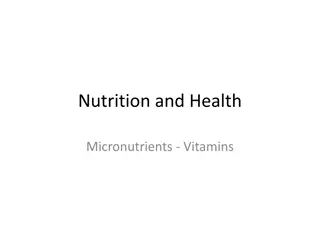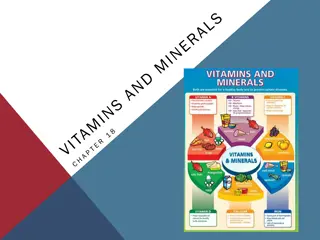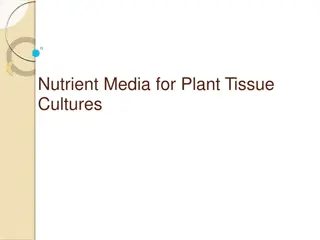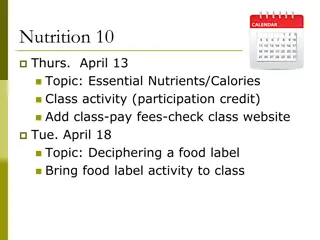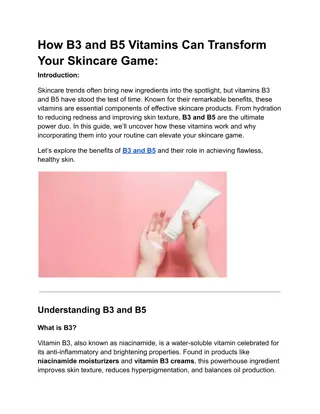Vitamins A and D: Essential Nutrients for Health
Vitamins A and D are essential nutrients required for maintaining various bodily functions such as immunity, metabolism, skin health, and bone growth. Vitamin A is crucial for vision, tissue repair, and bone health, while Vitamin D regulates calcium absorption and supports bone growth. Learn more about these vital vitamins and their sources.
Download Presentation

Please find below an Image/Link to download the presentation.
The content on the website is provided AS IS for your information and personal use only. It may not be sold, licensed, or shared on other websites without obtaining consent from the author.If you encounter any issues during the download, it is possible that the publisher has removed the file from their server.
You are allowed to download the files provided on this website for personal or commercial use, subject to the condition that they are used lawfully. All files are the property of their respective owners.
The content on the website is provided AS IS for your information and personal use only. It may not be sold, licensed, or shared on other websites without obtaining consent from the author.
E N D
Presentation Transcript
V Vitamin: because vitamins were originally thought to contain an amino acid. itamin: from Latin vita life + English amine, Vitamins are the nutrients, our bodies need in order to maintain functions such as immunity and metabolism. They are required in small quantities in the diet because they cannot be synthesized by the body.
Vitamins A, D, E, K: Not lost easily in cooking Lost when mineral oil is ingested Excess amounts are stored in the liver. Deficiencies are slow to appear. easily absorbed through the intestinal tract.
Vitamin A several fat-soluble vitamins found especially in animal products. Vitamin A : : Retinol Retinol Sources Sources of Vitamin of Vitamin A: A: Animal sources: Milk Meat Fish Liver Eggs Plant sources: Green leafy vegetables yellow fruits,red palm oil
Characteristics of Vitamin Characteristics of Vitamin A: A: Formation of blood cells and gene transcription. It is mainly necessary for body tissue repair, to maintain the skin and mucous membranes in good health. Build and take care of bones,hair,nails,teeth. Body stores fat soluble vitamins in the liver and appears in the retina of the eye in some components called retinoids correct vision. Act as antioxidant. retinoids.Eyes need it for a correct vision.
Functions of Vitamin maintain healthy skin, teeth, skeletal and soft tissue, mucus membranes, and skin. Vision: especially in low light . maintaining healthy immune function and deficiency can lead to an impaired response to infection. It may also be needed for reproduction and breast- feeding. Functions of Vitamin A: Body function A: Body function: Vitamin A helps form and Vision: Vitamin A promotes good vision, Immune system: Immune system: Vitamin A is essential for
VITAMIN Is synthesized in skin exposed to sunlight. VITAMIN D: D: Regulates the absorption of phosphorus and calcium during bone growth. Deficiency can result in weakened bones. Sources include cod liver oil, egg yolk, and enriched milk.
Characteristics of Vitamin Vitamin D is preventing and treating rickets, Vitamin D is also used for treating Weak bones (osteoporosis), bone pain (osteomalacia), bone loss hyperparathyroidism, inherited disease (osteogenesis imperfecta) in which the bones are especially brittle and easily broken. Preventing low calcium and bone loss (renal osteodystrophy) in people with kidney failure. Characteristics of Vitamin D: D:
Functions of Vitamin Immune system, which helps you to fight infection Muscle function Cardiovascular function, for a healthy heart and circulation Respiratory system for healthy lungs and airways Brain development Anti-cancer effects Functions of Vitamin D: D:
VITAMIN VITAMIN E E Tocopherols and tocotrienols. Sources Vegetable oils: corn, soybean, safflower, and cottonseed, and nuts, and green leafy vegetables. Sources of vitamin E : of vitamin E : Characteristics Vitamin E is considered the heart vitamin,since it is necessary to have vitamin E needs covered for a healthy heart As a fat-soluble antioxidant, it stops the production of reactive oxygen species formed when fat undergoes oxidation. Characteristics of Vitamin E of Vitamin E
Functions of Vitamin Antioxidant Prevention of hemolytic anemia among premature infants Enhances immune system Retards spoilage of commercial foods Vitamin E also has an effect on gene expression Functions of Vitamin E: E:
Vitamin K Vitamin K Made up of several compounds essential to blood clotting Vitamin K1 (phylloquinone) Vitamin K2 (menaquinone) Synthetic vitamin K (menadione) Vitamin K is destroyed by light and alkalis. Sources of Vitamin Green leafy vegetables such as broccoli, cabbage. Dairy products, cow s milk, eggs, meats, fruits, and cereals Bacteria in small intestine synthesizes some vitamin K, but must be supplemented by dietary sources. Sources of Vitamin K: K:
Functions of Vitamin Formation of prothrombin for clotting of blood Candidates likely to receive vitamin K Newborns immediately after birth After extensive antibiotic therapy Antidote for an overdose of anticoagulant or treatment of haemorrhage. Functions of Vitamin K: K:
Water Vitamin B complex and C Dissolve in water Easily destroyed by air, light, and cooking Cannot be stored and is readily extracted from the body. Vitamin antioxidant properties and protects food from oxidation Role in formation of collagen and absorption of nonheme iron. Prevents scurvy. May be involved with formation or functioning of norepinephrine, some amino acids, folate, leukocytes, the immune system, and allergic reactions Water- -Soluble Vitamins Soluble Vitamins Vitamin C: C: Ascorbic Acid
Functions of Vitamin C Vitamin C is required for the synthesis of collagen, the intercellular cement substance which gives structure to muscles, vascular tissues, bones, tendons and ligaments vitamin C contributes to the health of teeth and gums, preventing haemorrhaging and bleeding. vitamin C is also needed for the metabolism of bile acids which may have implications for bloodcholesterol levels and gallstones. vitamin C plays an important role in the synthesis of several important peptide hormones, neurotransmitters and carnitine. Anti-allergic Antioxidant Functions of Vitamin C : :
Vitamin B1 Vitamin B1 Thiamine. Sources include unrefined and enriched cereals, yeast, wheat germ, lean pork, organ meats. Characteristics It is unstable when exposed to ultraviolet light and gamma radiation. Thiamine is a colorless organosulfur compound soluble in water, methanol, and glycerol. Functions of Vitamin B1 The production of energy from food The synthesis of nucleic acids (e.g., DNA) The conduction of nerve impulses The normal function of the heart Characteristics of Vitamin B1 of Vitamin B1 Functions of Vitamin B1
Normal carbohydrate and energy-yielding metabolism The normal function of the nervous system Normal psychological functions Vitamin Vitamin B2 B2 Vitamin B2, also known as riboflavin, is one of eight B vitamins that are essential for human health. It is crucial for breaking down food components, absorbing other nutrients, and maintaining tissue. Necessary for the metabolism of carbohydrates, protein, and fats. Sources breads, cereals, broccoli, spinach, and asparagus Sources: milk, meats, poultry, fish, enriched
Functions of Vitamin Along with vitamin A, maintaining the mucous membranes in the digestive system Healthy eyes, nerves, muscles and skin the maintenance of normal red blood cells convert food (carbohydrates) into glucose, which is used to produce energy. convert vitamin B6 and vitamin B9 into active forms the reduction of tiredness and fatigue Functions of Vitamin B2: B2:
Vitamin B3 Niacin Is part of the coenzyme nicotinamide adenine dinucleotide (NAD+ ) involved in oxidation reduction reactions. Deficiency can result in dermatitis, muscle fatigue, and loss of appetite. Is found in meats, rice, and whole grains.
Vitamin B5 Pantothenic Acid Is part of coenzyme A needed for energy production as well as glucose and cholesterol synthesis. Deficiency can result in fatigue, retarded growth and anemia. Vitamin B5 Pantothenic Acid : : Functions: Part of coenzyme A Reduces stress, prevents tiredness Necessary for formation of glycogen, fatty acids, steroid hormones Functions: Sources heart, yeast Sources: whole grains, and vegetables ,eggs,liver,
Vitamin Vitamin B6 Pyridoxine B6 Pyridoxine : : Pyridoxine and pyridoxal are two forms of vitamin B6 , which are converted to the coenzyme pyridoxal phosphate (PLP). PLP is required in the transamination of amino acids and decarboxylation of carboxylic acids. Deficiency of pyridoxine may lead to dermatitis, fatigue, and anemia. Functions: Amino acids and protein metabolism Serves as a catalyst in conversion of tryptophan to niacin; helps synthesize neurotransmitters such as serotonin and dopamine Cure of anaemia Formation of red blood cells Functions:
Sources Sources: meat, fish, liver, vegetables, cereals, yolk. Vitamin Vitamin B7 B7 biotin biotin Coenzyme in synthesis of fatty acids and amino acids Biotin can only be synthesized by bacteria, molds, yeasts, algae, and by certain plant species. Sources include liver, egg yolk, soy flour, cereals, and yeast
Functions of Vitamin B7: activate protein/amino acid metabolism in the hair roots and fingernail cells. the maintenance of normal skin and mucous membranes A vitamin H supplement may help to reduce muscle pain. Produce fatty acids and amino acids (the building blocks of protein) Functions of Vitamin B7:
Vitamin Vitamin B12 B12 cobalamin cobalamin. . A key role in the normal functioning of the brain and nervous system, and for the formation of blood The body can store vitamin B12 for years in the liver. Involved in folate metabolism, maintenance of the myelin sheath, and healthy red blood cells To be absorbed, must bind with intrinsic factor in stomach.
Functions of Vitamin B12 Vitamin B12 is used for building proteins in the body, formation of red blood cells. Vitamin B12 is essential for the preservation of the myelin sheath around neurons and for the synthesis of neurotransmitters. It helps in the maintenance of the central nervous system. Functions of Vitamin B12 : :
Vitamin C Vitamin C Ascorbic acid Hypervitaminosis: addiction, diarrhea Hypovitaminosis: scurvy-4Ds Source: fruits,vegetables Ascorbic acid Functions: Hormone, collagen synthesis Infection resistance, cure of cuts. Functions:
